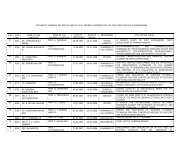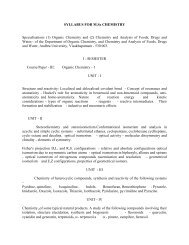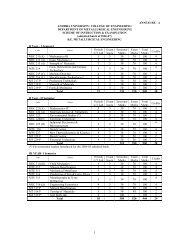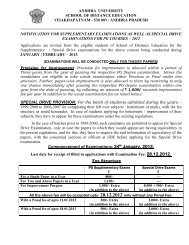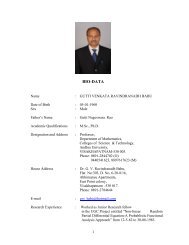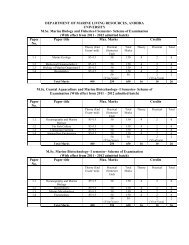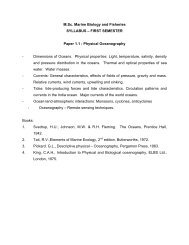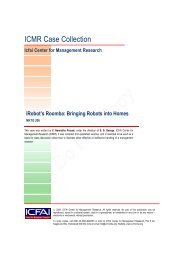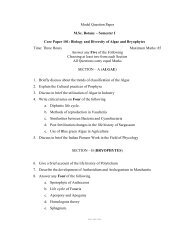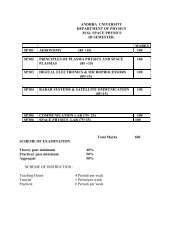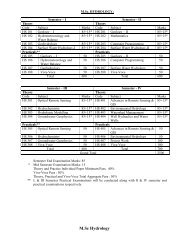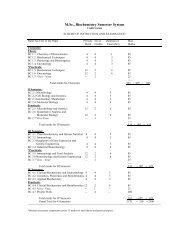Andhra University Department of Marine Living Resources M.Sc ...
Andhra University Department of Marine Living Resources M.Sc ...
Andhra University Department of Marine Living Resources M.Sc ...
You also want an ePaper? Increase the reach of your titles
YUMPU automatically turns print PDFs into web optimized ePapers that Google loves.
<strong>Andhra</strong> <strong>University</strong><br />
<strong>Department</strong> <strong>of</strong> <strong>Marine</strong> <strong>Living</strong> <strong>Resources</strong><br />
M.<strong>Sc</strong>. <strong>Marine</strong> Biology and Fisheries<br />
THIRD SEMESTER<br />
Paper 3.1 : Fishery <strong>Sc</strong>ience<br />
General Account <strong>of</strong> systematic classification <strong>of</strong> fishes. Classification based on<br />
degrees <strong>of</strong> movement, zones inhabited and manner <strong>of</strong> reproduction.<br />
Economically important groups <strong>of</strong> fishes: general and brief account <strong>of</strong><br />
elasmobranches, clupeoids, salmonoids, scombroids, gadoids, heterosomata,<br />
sciaenids, carangids. Trichiurids, cat fishes, crustaceans and molluscs.<br />
Natural populations or stocks as biological entities; factors limiting abundance <strong>of</strong><br />
stocks. Criteria for distinguishing units or multistock species. Idea <strong>of</strong> unit stock – its<br />
relevance to tropical marine fish.<br />
Population dynamics; recruitment, growth and mortality. Length – weight<br />
relationship, Condition Factor.<br />
General account <strong>of</strong> life history <strong>of</strong> Indian fishes: oil sardines, Indian shad,<br />
mackerel, Bombay duck and Malabar sole.<br />
Food and feeding habits <strong>of</strong> fishes (general account), reproduction and spawning<br />
(general account); fish eggs and larvae.<br />
Age determination <strong>of</strong> fishes; general account. Movement and migration in fishes: eel,<br />
salmon, Indian shad. Marking and Tagging <strong>of</strong> fishes (general account).<br />
Reference Books:<br />
1. Cushing D.H.: Fisheries Biology, <strong>University</strong> <strong>of</strong> Wisconsin press, 1968.<br />
2. Cushing D.H.: <strong>Marine</strong> ecology and fisheries, Cambridge <strong>University</strong> press, 1975.<br />
3. Jhingran V.G.: Fish and fisheries <strong>of</strong> India, Hindustan Publ. Corpn., 1991.<br />
4. Nelson J.S.: Fishes <strong>of</strong> the world, John Wiley, 1976.<br />
5. Royce W.F.: Introduction to fishery sciences, Academic Press, 1972.
Paper 3.2: Aquaculture – 1<br />
Role, status and importance <strong>of</strong> Aquaculture<br />
Criteria <strong>of</strong> selection <strong>of</strong> species for aquaculture.<br />
Culture practices <strong>of</strong> carps, milkfish and mullets.’<br />
Monoculture, polyculture and integrated farming.<br />
Culture practices <strong>of</strong> tiger shrimp, Macrobrachium rosenbergi, crabs and lobsters –<br />
Extension activities in aquaculture.<br />
Culture practices <strong>of</strong> edible oyster, mussel, cephalopod, clams, and <strong>Marine</strong> finfish.<br />
Culture practices <strong>of</strong> Seaweeds in India and abroad. Significance <strong>of</strong> mariculture in India.<br />
References:<br />
1. Bardach J.E. et al., Aquaculture, Wiley – interscience, 1972.<br />
2. IMAI t.: Aquaculture in shallow seas, Amerind Pub. Co. 1977<br />
3. Milne P.H.: Fish & Shellfish farming in coastal waters, FNB Ltd., 1972<br />
4. Pillay TVR & Wm. A.Dill: Advances in Aquaculture, FAO, 1979.<br />
5. Wheaton F.W.: Aquaculture engineering, Wiley-interscience, 1977.<br />
6. Jhingran V.G.: Fish & Fisheries <strong>of</strong> India, Hindustan Pub. Corp., 1982.<br />
7. Stickney R.R.: Principles <strong>of</strong> warm water aquaculture, Wiley interscience, 1979.<br />
8. Huet M. & Timmermans: Textbook <strong>of</strong> fish culture, FNB Ltd., 1986.<br />
9. T.V.R. Pillay: Aquaculture: Principles & Practices, FNB Ltd., 1981.
Paper 3.3: Biochemistry and Physiology<br />
Introduction to Biochemistry. Proteins – Structure, Isolation, Purification, Denaturation –<br />
amino acids – Fish proteins. Lipids – Fish lipids – auto oxidation – rancidity –<br />
antioxidants.<br />
Enzymes – Classification, factors influencing enzyme activity, Role <strong>of</strong> enzymes in<br />
metabolism.<br />
Biological Oxidation – Metabolism <strong>of</strong> Carbohydrates, Proteins and Lipids with reference<br />
to fishes.<br />
Physiology <strong>of</strong> digestion, reproduction and neurosecretions in fin fishes and shell fishes.<br />
Moulting and growth in decapods crustaceans: regulating factors.<br />
Neurohormones and endocrine glands and their functions in finished and shell fishes.<br />
References:<br />
1. Bardach J.E. et al. Aquaculture: Wiley-interscience, 1972.<br />
2. Conn F.E. & P.K.Stump: Outlines <strong>of</strong> Bio-Chemistry, Willey Eastern Ltd., 1989.<br />
3. Halver J.E.: Fish Nutrition, Academic Press, 1972.<br />
4. Hepher B.: Nutrition <strong>of</strong> Pond Fishes, Cambridge <strong>University</strong> Press, 1969.
Paper 3.4: <strong>Marine</strong> Pollution<br />
<strong>Marine</strong> Pollution: Definition by GESAMP, major sources <strong>of</strong> pollution, dynamics,<br />
transport paths and agents.<br />
Toxicology: Lethal and sub lethal effects <strong>of</strong> pollutants on marine organisms, evaluation<br />
<strong>of</strong> toxicity tolerance, bioassay.<br />
Enzymatic removal <strong>of</strong> hazardous organic substances from aqueous effluents.<br />
Sewage: Domestic, Industrial, agricultural and aquacultural discharges, their<br />
composition and fate in the marine environment, toxicity and treatment methods,<br />
sewage disposal system.<br />
Environmental Impact Assessment Methods <strong>of</strong> aquaculture activities.<br />
Oil pollution: Sources and fate <strong>of</strong> oil, composition and toxicity <strong>of</strong> oil, biological effects<br />
treatment procedures.<br />
Thermal and radioactive pollutants: Source and characteristics, strategies for<br />
disposal <strong>of</strong> RNA and Heated effluents, biological effects and alternative uses <strong>of</strong> waste<br />
dumping, mining and dredging operations, their effects on the organisms and marine<br />
environment.<br />
Text Books/References:<br />
1. S.E. Nielsen: Tropical Pollution, 1982.<br />
2. A.M.Chakravarthy Biodegradation and detoxification <strong>of</strong> Environmental pollutants,<br />
CRC Press, 1928.<br />
3. O.Kinne: <strong>Marine</strong> Ecology, Vol.V.Ocean Management 3&4, John Wiley & Sons,<br />
1984.<br />
4. Johnston R. (Ed.) : <strong>Marine</strong> Pollution, Academic Press, 1976.<br />
5. Patin. S.A.: Pollution and Biological resources <strong>of</strong> the Oceans Butterworth & Co.<br />
Ltd., 1982.<br />
6. Ruive M. (Ed.) : <strong>Marine</strong> Pollution and Fishing News Sea Life, 1972.<br />
7. Venugopalan, V.K.: Pollution and Toxicology, CAS in <strong>Marine</strong> Biology, 1991.<br />
8. Rita Colwell (Ed.): Biotechnology in <strong>Marine</strong> <strong>Sc</strong>iences, Academic Press, 1981.<br />
9. Prakesh P.: Textbook <strong>of</strong> <strong>Marine</strong> Pollution.<br />
10. Gupta, P.K.: Introduction to Biotechnology.
M.<strong>Sc</strong>. <strong>Marine</strong> Biology and Fisheries<br />
FOURTH SEMESTER<br />
Paper 4.1 : Fishing Technology and Fisheries Management<br />
Evolution <strong>of</strong> fishing crafts: Boat types and their classification, types <strong>of</strong> boats used in<br />
India.<br />
Evolution <strong>of</strong> fishing hooks and baits.<br />
Evolution and classification <strong>of</strong> fishing gears; description <strong>of</strong> hand-line, troll line and pole<br />
line; description, design and fabrication <strong>of</strong> trawl nets, purse-seine, gill nets.<br />
Fisheries oceanography: General account <strong>of</strong> effects <strong>of</strong> environmental parameters like<br />
temperature, currents, light and salinity on fish biology, behaviour and<br />
abundance.<br />
Stock assessment : Collection <strong>of</strong> basic data, stock size. yield models.<br />
The effects <strong>of</strong> exploitation. The over fishing problem. Management techniques, fishing<br />
regulations.<br />
The future <strong>of</strong> fisheries research; development and management strategies.<br />
Text Books:<br />
1. R.R.Colwell (ed) Biotechnology in <strong>Marine</strong> <strong>Sc</strong>ience. 1982<br />
2. Aitikin, A. Fish handling & processing. 2 nd edition, 1982<br />
3. Baranov, F.I Selected works in fishing gear Volume-1: 1978<br />
4. Borgstorm, G Fish as Food Vol.I,III & IV Academic Press 1961, 1965<br />
5. Brandt, A.V. Fish catching methods <strong>of</strong> the world, 3 rd edition,<br />
Fishing News Books Ltd. 1971<br />
6.connell, J.J Control <strong>of</strong> fish quality, Fishing News Books Ltd<br />
7. Sanisburry, J.C Commercial Fishing Methods,<br />
1975<br />
Fishing News Books Ltd 1971<br />
8. Cushing, D.H Fishing Biology. <strong>University</strong> <strong>of</strong> Wisconsin press 1968<br />
9. Cushing, D.H <strong>Marine</strong> ecology and fisheries. Cambridge <strong>University</strong> Press 1975
10. Jhingran, V.G Fish and Fisheries <strong>of</strong> India Hindustan Publ. Corp. 1991<br />
11. Nelson, J.S Fished <strong>of</strong> the world John Wiley Publ.<br />
References:<br />
1976<br />
1. Cushing D.H.: Fisheries Biology, <strong>University</strong> <strong>of</strong> Wisconsin Press, 1968.<br />
2. Cushing D.H.: <strong>Marine</strong> Ecology and fisheries, Cambridge <strong>University</strong> Press, 1975.<br />
3. Jhingran V.G.Fish and fisheries <strong>of</strong> India, Hindustan Publ. Corpn., 1991.<br />
4. Nelson J.S.: Fishes <strong>of</strong> the world, John Wiley, 1976.
Paper 4.2: Fish Processing Technology<br />
Chemical composition <strong>of</strong> fish and shellfish: moisture, protein, fat, carbohydrates,<br />
ash etc.<br />
Microbiology <strong>of</strong> fresh and processed fish: Morphology <strong>of</strong> bacteria: growth and<br />
reproduction <strong>of</strong> bacteria: effect <strong>of</strong> environmental factors like temperature, pH, oxygen,<br />
moisture, etc.<br />
Common bacteria present in fish; identification and isolation. Bacteria <strong>of</strong> sanitary<br />
significance.<br />
Handling <strong>of</strong> fish: spoilage <strong>of</strong> fish and shellfish; effect <strong>of</strong> temperature on fish spoilage,<br />
use <strong>of</strong> ice;<br />
Solid carbon dioxide and liquid nitrogen in fish preservations; containers for packaging<br />
and transportation <strong>of</strong> fish, handling on board fishing vessels and on shore ;use <strong>of</strong><br />
chemical preservatives and irradiation in extending shelf life <strong>of</strong> fish and shell fish.<br />
Canning : Principles <strong>of</strong> canning; canning materials; handling and preparation <strong>of</strong> fish and<br />
shellfish for canning; spoilage <strong>of</strong> canned fish; chemical and microbiological spoilage and<br />
their prevention.<br />
Curing: Salting <strong>of</strong> fish-principles and practices; pickling; smoked fish; spoilage <strong>of</strong> cured<br />
fish.<br />
Freezing <strong>of</strong> fish: techniques <strong>of</strong> freezing; different types <strong>of</strong> freezers; changes during<br />
freezing and storage <strong>of</strong> fish; effects <strong>of</strong> freezing on proteins, lipids and bacteria, spoilage<br />
<strong>of</strong> frozen fish and shellfish; denaturation <strong>of</strong> proteins, lipid hydrolysis; fat oxidation,<br />
protection <strong>of</strong> frozen fish; glazing and wrapping; use <strong>of</strong> anti-oxidants; thawing <strong>of</strong> frozen<br />
fish, double freezing <strong>of</strong> fish; storage, transportation and distribution <strong>of</strong> frozen fish,<br />
industrial methods <strong>of</strong> freezing fish and shellfish; production and freezing <strong>of</strong> fish fillets,<br />
minced meat and fish fingers.<br />
Byproducts: processing <strong>of</strong> low cost fish, minced meat, fish oil, fish meal, fish<br />
sausages, isinglass, glue, fish silage, chitosan, chitin pearl essence, alginates, agar and<br />
corals.<br />
Text Books:
1. R.R. Colwell (ed): Biotechnology in <strong>Marine</strong> <strong>Sc</strong>ience, 1982.<br />
2. Aitikin, A: Fish handling & processing 2 nd edition, Min. Agr. Fish and Food, U.K.,<br />
1982.<br />
3. Borgstorm, G. : Fish as Food Vol. I, III and IV, Academic Press, 1961, 1965<br />
4. Brandi, A.V.: Fish catching methods <strong>of</strong> the World, 3 rd edition, Fishing News<br />
Books ltd. 1984.<br />
5. Connel, J.J.: Control <strong>of</strong> Fish Quality, Fishing News Books Ltd., 1975.<br />
6. Sanisburry, J.C.: Commercial Fishing Methods, Fishing News Books Ltd., 1971.<br />
References:<br />
1. Connell J.J. : Advances in fish science and technology, Fishing News Books Ltd.,<br />
1980.<br />
2. Nedelec C.: FAO catalogue <strong>of</strong> small scale fishing gear, FAO (FNB).
Paper 4.3.: Aquaculture II<br />
Design, construction and management <strong>of</strong> aquaculture i.e. pond, cages, pens, rafts and<br />
long lines.<br />
Technical and non technical considerations in site selection.<br />
Engineering survey principles and procedures. Selection <strong>of</strong> material and equipment.<br />
Finfish and shellfish hatcheries – Seed production.<br />
Diseases in aquaculture organisms, Prevention and treatment methods<br />
Environmental impact assessment in Aquaculture.<br />
Reference Books:<br />
1. Imai T.: Aquaculture in shallow seas, Amerind Pub. Co., 1977<br />
2. Milne P.H.: Fish & Shellfish farming incoastal waters, FNB Ltd., 1972.<br />
3. Pillay TVR & Wm. A. Dill: Advances in Aquaculture, FAO, 1979.<br />
4. Wheaton F.W.: Aquaculture engineering, Wiley- interscience, 1977.<br />
5. Jhingran V.G.: Fish & Fisheries <strong>of</strong> India Hindustan Pub. Corp., 1982<br />
6. Stickney R.R.: Principles <strong>of</strong> warm water aquaculture, Wiley – interscience, 1976.<br />
7. A.E. Alilis: Fish and Shellfish pathology, Acad. Pr., 1986.<br />
8. T.V.R.Pillay : Aquaculture: Principles & Practices, FNB Ltd., 1981.
Paper 4.4.: Biotechnological Applications in Aquaculture<br />
Role <strong>of</strong> biotechnology in aquaculture.<br />
Nutritional Biotechnology – Principles <strong>of</strong> nutrition – nutritional requirements <strong>of</strong> cultivable<br />
finfishes and shell fishes at different stages <strong>of</strong> life – Energitics <strong>of</strong> fod conversion –<br />
growth promoters – source <strong>of</strong> food – natural and artificial live feed – collection, culture<br />
and their utilization. Artificial feeds – formulated feeds – feed formulations – methods<br />
and strategies. Importance ad use <strong>of</strong> antioxidants and antibiotics in feeds – feed<br />
storage.<br />
Reproductive Biotechnology: Breeding biology and endocrine control <strong>of</strong> reproduction in<br />
fin fishes and shell fishes – in induced breeding – egg incubation and larval rearing.<br />
Principles <strong>of</strong> genetics – fish cytogenetics – application <strong>of</strong> genetics in aquaculture<br />
– genetic selection, hybridization, inbreeding and cross breeding, sex control,<br />
cryopreservation, in vitro fertilization, artificial insemination, polyploidy, transgenesis.<br />
Development <strong>of</strong> disease resistant and high quality strains.<br />
References:<br />
1. Bardach J.E. et al., Aquaculture, Wiley-interscience, 1972.<br />
2. Conn F.E. & P.K.Stump: Outlines <strong>of</strong> Bio-chemistry, Willey Eastern Ltd., 1989.<br />
3. Halver J.E., Fish Nutrition, Academic Press, 1972.<br />
4. Hepher B.: Nutrition <strong>of</strong> Pond Fishes, Cambridge <strong>University</strong> Press, 1969.<br />
5. Hoar W.S. & D.J. Randall: Fish Physiology, Academic Press, 1969.<br />
6. Huet. M & J.Timmermens: Textbook <strong>of</strong> Fish Culture: Breeding and Cultivation <strong>of</strong><br />
Fish, 2 nd edition, Fishing News books, 1989.<br />
7. Jhingran V.G., Fish and Fisheries <strong>of</strong> India, 2 nd edition, Hindustan Pub., 1991.
Paper 4.5: Environmental Monitoring and Biodeterloration<br />
Global environmental monitoring methods: Status and objectives, limitations for<br />
monitoring critical pollutants.<br />
Role <strong>of</strong> biotechnology in environmental pollution control: Indicator organisms, Test<br />
organisms, Monitoring organisms, Enzymes.<br />
Coastal developmental activities-environmental issues.<br />
Micro and Macro fouling, corrosion <strong>of</strong> metals and alloys in the sea, effects <strong>of</strong> bio-fouling<br />
and bio deterioration on marine structures.<br />
Protection methods against corrosion and fouling Application <strong>of</strong> biotechnology in<br />
controlling the bio deterioration <strong>of</strong> wood and synthetic substances in the sea.<br />
Red tides: Cause character and effects on the organisms <strong>of</strong> <strong>Marine</strong> environment<br />
Text Books/References:<br />
1. S.E. Nielsen: Tropical Pollution, 1982.<br />
2. A.M.Chakravarthy: Biodegradation and detoxification <strong>of</strong> Environmental pollutants,<br />
CRC Press, 1928.<br />
3. o.Kinne: <strong>Marine</strong> Ecology, Vol.V. Ocean Management 3&4 John Wiley & Sons.<br />
1984.<br />
4. Johnston R. (Ed.) : <strong>Marine</strong> Pollution, Academic Press, 1976.<br />
5. Patin S.A.: Pollution and Biological resources <strong>of</strong> the Oceans Butterworth & Co.<br />
Ltd., 1982.<br />
6. Ruive M. (Ed.) : <strong>Marine</strong> Pollution and Fishing News Sea Life 1972.<br />
7. Venugopalan, V.K. : Pollution and Toxicology, CAS in <strong>Marine</strong> Biology, 1991.<br />
8. Rita Colwell (Ed): Biotechnology in <strong>Marine</strong> <strong>Sc</strong>iences, Academic Press, 1981.<br />
9. Prakash P.: Textbook <strong>of</strong> <strong>Marine</strong> Pollution.<br />
10. Gupta, P.K. : Introduction to Biotechnology.



